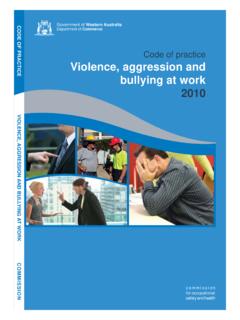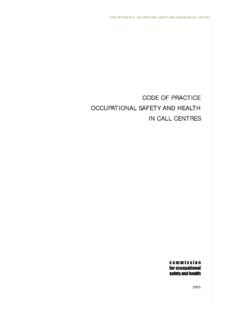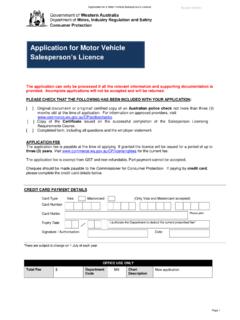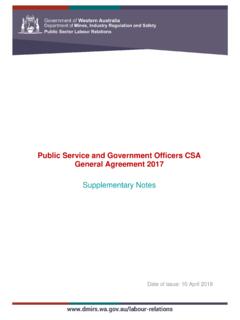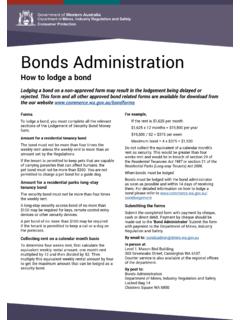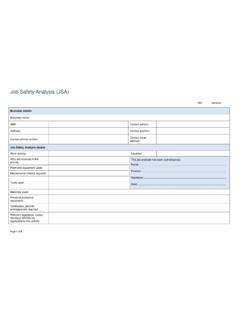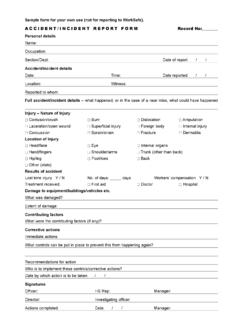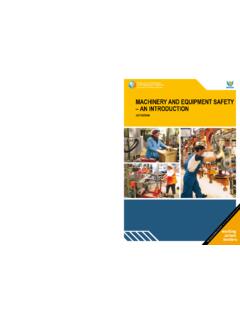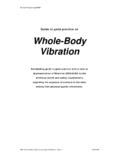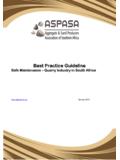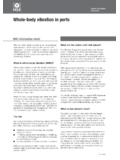Transcription of Manual tasks code of practice - commerce.wa.gov.au
1 Government of Western Australia CODE OF practice . Department of Commerce Code of practice Manual tasks 2010. Manual tasks . C OMM IS SION. commission for occupational safety and health Code of practice Manual tasks . Code of practice Manual tasks 2010. commission for occupational safety and health Code of practice Manual tasks . Foreword This code of practice is issued by the Commission for Occupational Safety and Health (the Commission). under the Occupational Safety and Health Act 1984 (the OSH Act). The Commission's objective is to promote comprehensive and practical preventive strategies that improve the working environment of Western Australians. This code of practice has been developed through a tripartite consultative process and the views of employers and unions, along with those of government and experts, have been considered. Legislative framework for occupational safety and health The Occupational Safety and Health Act 1984.
2 The OSH Act provides for the promotion, co-ordination, administration and enforcement of occupational safety and health in Western Australia. It applies to all workplaces with the exception of mining and petroleum. The OSH Act places certain duties on employers, employees, self-employed people, manufacturers, designers, importers and suppliers. It also places emphasis on the prevention of accidents and injury. In addition to the broad duties established by the OSH Act, the legislation is supported by regulations, together with a lower tier of non-statutory codes of practice and guidance notes. Occupational Safety and Health Regulations 1996. The Occupational Safety and Health Regulations 1996 (the OSH regulations) prescribe minimum standards and have a general application, or define specific requirements related to a particular hazard or type of work. They may allow licensing or granting of approvals and certificates.
3 If there is a regulation about a risk in the OSH Regulations, it must be complied with. Codes of practice published under the OSH Act A code of practice is a document prepared for the purpose of providing: practical guidance on how to comply with a general duty under the OSH Act or specific duties under the OSH Regulations;. without being prescriptive, practical guidance on safe work practices that can be used to reduce the risk of work-related injury and disease; and a practical means of achieving any code, standard, rule, provision or specification relating to occupational safety and health in Western Australia. A code of practice may contain explanatory information. However, work practices included may not represent the only acceptable means of achieving the standard to which the code refers. Compliance with codes of practice is not mandatory but a code may be used by courts as the standard when assessing other methods or practices used.
4 A code of practice does not have the same legal force as a regulation and non-compliance is not sufficient reason, of itself, for prosecution under the OSH Act. Note that there may be additional risks at the workplace not specifically addressed in this code of practice . The OSH Act requires identification of them and implementation of control measures to prevent or minimise exposure. Code of practice Manual tasks . Scope and application of this code In May 2010, the Minister for Commerce approved this code under section 57 of the OSH Act. This document replaces the Western Australian Code of practice : Manual handling and the National code of practice for the prevention of occupational overuse syndrome, as approved codes of practice in Western Australia. This code of practice applies to all workplaces in Western Australia covered by the OSH Act. It provides: general guidance for employers and workers on the identification, assessment and control of safety and health hazards and risks associated with Manual tasks in which forces exerted, loads handled, repetitive movement, awkward postures, sustained postures and equipment and tools that expose workers to vibration are of concern; and information on key legislative requirements in the OSH Act and the OSH Regulations, as they relate to hazardous Manual tasks .
5 Benefits of using this code of practice The benefits of implementing programs to eliminate or reduce the risk arising from performing Manual tasks include: preventing injury, illness, pain and suffering of individuals in the workplace;. improved business performance, efficiency and productivity;. fewer workers' compensation claims, which may lead to lower premiums;. faster and easier return to work for workers who do sustain an injury;. fewer absences from work and less disruption;. retention of skilled workers; and a safe workplace with a positive safety culture. Disclaimer The information contained in this publication is provided in good faith and believed to be reliable and accurate at the time of publication. However, the information is provided on the basis that the reader will be solely responsible for assessing the information and its veracity and usefulness.
6 The State shall in no way be liable, in negligence or howsoever, for any loss sustained or incurred by anyone relying on the information, even if such information is or turns out to be wrong, incomplete, out-of-date or misleading. In this disclaimer: State means the State of Western Australia and includes every Minister, agent, agency, department, statutory body corporate and instrumentality thereof and each employee or agent of any of them;. information includes information, data, representations, advice, statements and opinions, expressly set out or implied in this publication; and loss includes loss, damage, liability, cost, expense, illness and injury including death. Code of practice Manual tasks . Contents 1. Overview of general 2. Hazardous Manual How does performing Manual tasks result in injury?..3. Risk factors in performing Manual Preventing injuries from performing Manual Important 3.
7 Step 1: Hazard What is required?..7. How do you identify hazards?..7. Where to from here?..9. 4. Step two: Risk What is required?..10. How to assess Where to from here?..12. 5. Step three: Risk What is required?..13. Finding solutions Developing control Finding solutions Putting in Where to from here?..19. 6. Follow up and Three stages of follow Appendix 1: Step 1 Manual tasks : Hazard identification form (example)..21. Appendix 2: Step 2 Manual tasks : Risk assessment form (example)..22. Appendix 3: Step 3 Manual tasks : Risk control and follow up form (example)..27. Appendix 4: Guidance material for rating risk Appendix 5: Other sources of Code of practice Manual tasks . 1. Introduction Almost all jobs include work that involves performing some form of Manual task. This code of practice provides practical guidance for managing risks associated with those Manual tasks that have the potential to cause or contribute to injury or illness.
8 Interpretation For the purposes of this code, the following definitions are provided. Manual tasks refers to any activity or sequence of activities that requires a person to use their physical body (musculoskeletal system) to perform work including: Manual handling (the use of force in lifting, lowering, pushing, pulling, carrying or otherwise moving, holding or restraining any person, animal or thing);. performing repetitive actions;. adopting awkward or sustained postures; and using plant, tools or equipment that exposes workers to vibration. Activity refers to the movements or postures adopted at any given time in order to perform a Manual task. Hazard means anything that may result in injury or harm to the health of a person. Those Manual tasks that have the potential to cause injury or disease are referred to in this code of practice as hazardous Manual tasks .
9 Hazardous Manual tasks include: (a) Manual tasks having any of the following characteristics: i. forces exerted by the worker (eg lifting, lowering or carrying) or on the worker by an item, person or animal (eg restraining a dog);. ii. awkward postures (eg bending forwards, twisting or reaching);. iii. sustained postures (eg prolonged sitting or standing);. iv. repetitive movements (eg repeating an action frequently, without breaks);. v. vibration whole-body (eg sitting in certain vehicles) and hand-arm (eg using certain powered tools);. (b) Manual tasks involving the handling of a person or an animal; or (c) Manual tasks involving the handling of unstable or unbalanced loads or loads difficult to grasp or hold. Musculoskeletal disorder means an injury or disease of the musculoskeletal system. Risk in relation to any injury or harm, means the probability of that injury or harm occurring.
10 1. Code of practice Manual tasks . Overview of general duties General duty of care' and general duties' are terms used to refer to the duties that the OSH Act places to, For more as far as practicable, ensure workers' safety and upon people to ensure their own safety at work and that information of others who are at the workplace or who might be injured by their work. on the dutty of care' People and organisations who have general duties under the OSH Act are: obligations, see the Commission's employers; agents who are in the business of hiring out workers (labour hire organisations) and their guidance employees;. note, General clients (host employers);. duty of care self-employed people;. in Western workers who are hired out to a host Australian principals (people who engage contractors employer by a labour hire company;. workplaces in the course of their trade or business).
